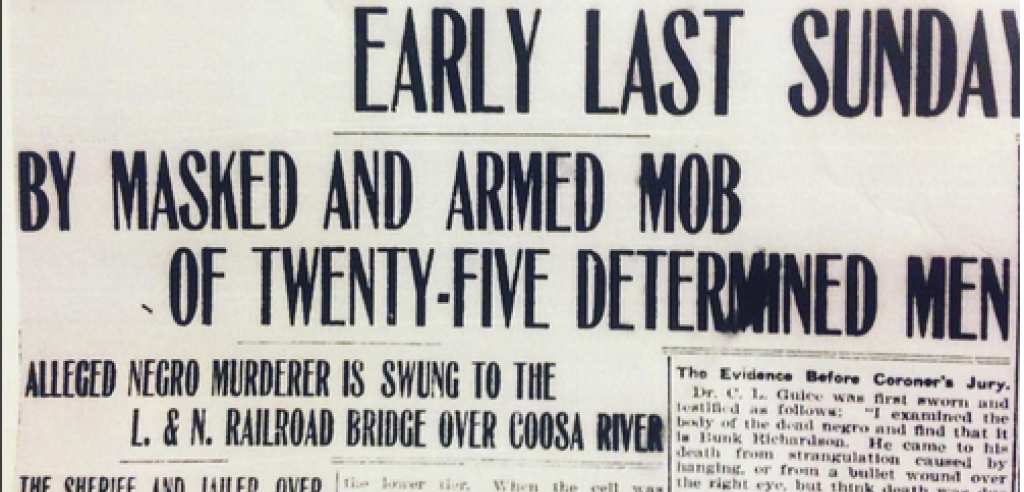In partnership with the City of Gadsden and Gadsden Reads, EJI dedicated a historical marker yesterday to commemorate the 1906 lynching of Bunk Richardson. A crowd of 200 people gathered to hear reflections, music and poetry before the marker was unveiled. Last night’s marker follows recent lynching markers EJI has erected in Abbeville, South Carolina and Letohatchee, Alabama.
The Lynching of Bunk Richardson
In the middle of the night on February 11, 1906, a large white mob abducted Bunk Richardson from the Etowah County Jail in Gadsden and lynched him.
In July 1905, three men were accused of rape and murder of a white woman. Bunk Richardson was not involved in the crime but knew one of the suspects and was also arrested. After the four were taken to the jail in Gadsden, a mob of 300 people gathered to lynch the suspects. The mob was successfully held back and the four prisoners were taken to Jefferson County the following day.
Two of the men, Jack Hunter and Vance Gardner, were later tried, convicted, and executed in Gadsden for the crime. The third, Will Johnson, was also convicted and sentenced to death, but Alabama Governor William Jelks doubted Mr. Johnson’s guilt and commuted his sentence to life in prison. Mr. Johnson was sent back to Jefferson County to serve his sentence.
The commutation of Will Johnson’s sentence sparked outrage in Gadsden, and a mob responded by seizing Bunk Richardson from the jail although he had never been charged with the crime. The mob dragged Mr. Richardson down the street and hung him from the train trestles crossing over the Coosa River. Mr. Richardson’s relatives were forced to leave town and abandon thriving businesses while the entire Black community lived in fear.
No one was ever charged for the lynching of Bunk Richardson.
Lynching in America
Thousands of Black people were the victims of lynching and racial violence in the United States between 1877 and 1950. The lynching of African Americans during this era was a form of racial terrorism intended to intimidate Black people and enforce racial hierarchy and segregation.
Lynching was most prevalent in the South. After the Civil War, violent resistance to equal rights for African Americans and an ideology of white supremacy led to violent abuse of racial minorities and decades of political, social, and economic exploitation.
Lynching became the most public and notorious form of terror and subordination. White mobs were usually permitted to engage in racial terror and brutal violence with impunity. Many Black people were pulled out of jails or given over to mobs by law enforcement officials who were legally required to protect them. Terror lynchings often included burning and mutilation, sometimes in front of crowds numbering in the thousands.
In response to this racial terror and violence, millions of Black people fled the South and could never return, which deepened the anguish and pain of lynching. Many of the names of lynching victims were not recorded and will never be known, but EJI has documented more than 350 lynchings in Alabama alone.
Dedication and Essay Contest
The dedication event featured Vanessa Croft, whose uncle, Fred Croft, survived a near-lynching in Gadsden after the 15-year-old was falsely accused of pushing a white girl. Fred’s parents acted quickly to send Fred out of Alabama before the lynch mob returned for him in part because they had seen what happened to Bunk Richardson three decades earlier.
The program featured Robert Avery, a notable local figure during the civil rights movement, who formally recognized unsung local human rights heroes who participated in nonviolent integration efforts during the 1950s and 1960s and were targeted for assassination attempts and bombings. Chari Bostick, director of Grace Heritage Community Development, also spoke about Sixth Street Cemetery. Originally created in 1826 as a burial site for enslaved people, this cemetery features over 500 graves, including that of Mr. Bunk Richardson. The cemetery fell into disrepair following the Urban Renewal related razing of the historically African American neighborhoods that once surrounded the site. Ms. Bostick encouraged the audience to manifest their commitment to community remembrance by supporting efforts to restore Sixth Street Cemetery.
The winners of EJI’s Racial Justice Essay Contest were announced and awarded a total of $5000 in scholarships for college. First place went to ninth grader Tobi Akisanya and senior Asia Polk, who both attend Gadsden City High School. Junior JacQuez King won second place, and third place was awarded to Mary Margaret McCartney, a junior at Episcopal Day School.


